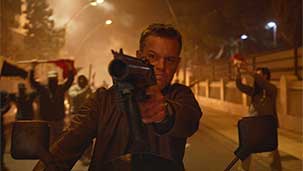On a list of exciting (and sometimes dangerous careers) working a Steadicam on a Bourne film would probably rank pretty high. The bragging rights alone, if you happened to survive the shoot, would guarantee you wouldn’t have to buy any drinks for a year. Minimum.
“Remember that time I jumped from one building to another, across an alley, through a window, all the while wearing a 200 pound Steadicam rig? Vodka shot please.”
Paul Greengrass, The director of two previous Bourne films as well as _Jason Bourne, loves shooting guerilla style. And while his films are filled with quick cuts and often look like they are filmed just with handheld camcorders, Steadicam technology allows Greengrass to create unique action sequences that seem to have their own gravitational field; So instead of simply watching them, it feels like you’re being pulled inside of them.
There is an interesting visual conceit at work in his Bourne films—including this one—that involve the contrast between how serene and conventional the interior shots are (specifically scenes populated by CIA analysts and their superiors) versus how kinetic and disorienting the camerawork is when shooting outdoors, or in less-controlled circumstances. This contrast underlines how bloodless technocrats think and live in a world of real-politik, often untouched by the fallout of their intrigues, while the rest of us (including Jason Bourne) are stuck negotiating the messy, disjointed, and often baffling hurricane of consequences these intrigues cause.
Bourne’s real talent is his ability to operate in this whirlwind with clarity and precision—to see what really matters while filtering out the rest. And to make use of whatever tools that come to hand. My wife Sarah remarked after the screening that one of the things she enjoys most about Jason Bourne is the anticipation of his competence—that it is as much fun waiting for him to put some mundane article to good use (a pen or a towel, just for instance) as it is to actually watch it play out on screen.
These are oddly cerebral films, given how much they utilize stunt work and action sequences to anchor what is essentially one long bout of existential angst. But it is the logistical complexity of these scenes, along with their exquisite technical execution, that raises them above most other films in this genre.
Jason Bourne is definitely not for everyone. It requires close attention, and often the audience is required to make leaps, that while clearly delineated, aren’t always overt. There is the occasional moment that seems a little trite, like when a flash drive actually has the word encrypted written on it, but that is likely an attempt to expedite what is often very fast moving exposition.
The last thirty-five minutes of this film must have been strenuous for you and your fellow camerapersons. There is non-stop, on-the-ground motion involving foot chases, crowded hotel lobbies, casino interiors and endless Las Vegas traffic—not to mention an unforgettable, if slightly absurd car chase.
Jason Bourne is exactly what you want from one of these films, and if it has any real weakness, it might be just that—there were moments where I felt that maybe the filmmakers had leaned a little too hard on what had come before. But those moments were few and far between. And the amazing work you did is the cornerstone of what was best about Jason Bourne.
So, if we ever happen to meet, the first vodka’s on me.
Sincerely,

Tim







